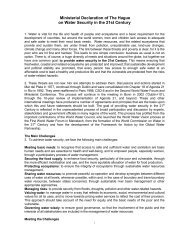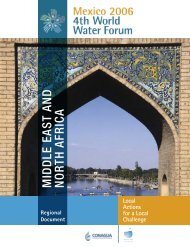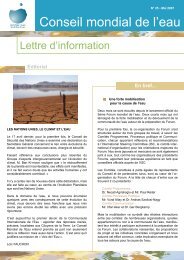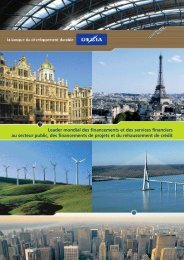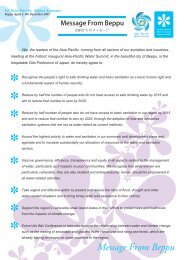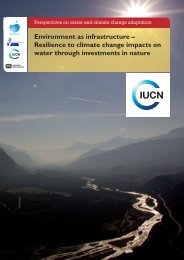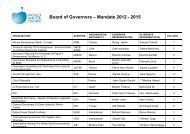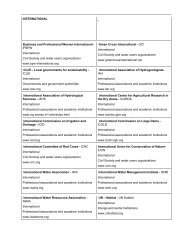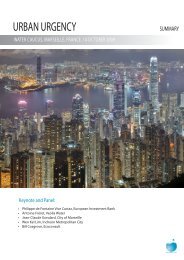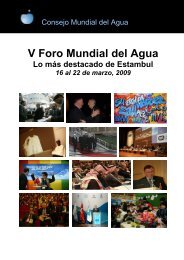Americas ok.indd - World Water Council
Americas ok.indd - World Water Council
Americas ok.indd - World Water Council
You also want an ePaper? Increase the reach of your titles
YUMPU automatically turns print PDFs into web optimized ePapers that Google loves.
1324th <strong>World</strong> <strong>Water</strong> ForumImpact of implemented activity (social, economical, environmental, etc.)Up to date we have established 87 plants of Reverse Osmosis in the State;57 plants with a capacity of 5,000 liters per day; 2 plants of 10,000 L/day; 15plants with 2000 L/day, and the rest with capacities from 1,000 to 400 L/day.This action had benefited a population of approximately 53,042 dwellersof mountain highland towns and arid soil zones, located in 23 among the 67state municipals.The economical input to these populations has been significant, as theyare provided with potable water for their ingestion at much lower prices thanthose of bottling commercial companies.Types of stakeholders involvedThe accomplishments were fully an intelligent decision of the Central Boardfor <strong>Water</strong> and Sanitation for granting a rational solution the problem of thedeterioration of water in those regions. The <strong>Water</strong> Committees of small towns,joined with the Rural and Municipal Boards, are responsible of supervising thecorrect operation. Central Board technical personnel provide regular supportby checking the plants to assure a proper functioning and supply necessarymaintenance.Means of stakeholder involvement and role they play(ed): The <strong>Water</strong> QualityDepartment was liable for designing a low cost solution to supply potablewater, within norm compliance, for those populations with accelerateddeterioration in their source detected by their strong tendency to highconcentration of aforesaid contaminants.The first plants began working with equipment providers supportapproximately two years ago.The experience in the operation of these plants allowed modifying severalfactors that were included in the second and third generation of such plants.Moreover, the use of solar panels permitted the setting up of Reverse Osmosisplants in places lacking electric energy supply.Long-term commitment and targets: Nowadays the installation of additional106 plants is programmed, intending to be built and operating in year 2006.W consider that Chihuahua State, due to its geo-hydrological nature, willcontinue demanding these solutions, so in the medium term we foresee ahorizon with a higher number of Reverse Osmosis units, and perhaps alsoanother type of specific plants for removing other contaminants by differentprocesses. The Research and Development efforts are focused upon thispurpose.Originality and Innovative Ideas: Investigations and detailed surveillance ofoperating plants leads us to enhancements in methods and/or processes forlarger operation cycles before the scheduled maintenance, assuring a longermembranes life.Costs involvedThe approximate cost of this type of plant is roughly $ 200,000.The applied resources were from the Normal State Investment (INE)Lessons learned that you would propose to present at the4th <strong>World</strong> <strong>Water</strong> ForumExperiences derived form installation of Reverse Osmosis plants to assurepotable water for ingestion of a specific population allow us to confirm thatit is a low investment solution for a world that is suffering climatic changesderived from the orchard effect, in addition to devastation of woods andhuman groups that contribute to water scarcity and contamination.Our professional conclusion is to recommend simple operations with consmall plants, not lo<strong>ok</strong>ing for processing huge water volumes, but aiming toinstall a higher number of unities to ease community dwellers utilization.Presently we have several plants in the same community, and due to theseservice plants people are no longer forced to walk large distances for theirwater supply, as well as avoiding crowds and rows in a larger unit.Local actions details:IDLA0563First name Armando Last name Varela PalaciosOrganizationSEMARNAT Federal Delegation in Hidalgo StateCountryMexicoGenderMaleEmailforestales@hidalgo.semarnat.gob.mxScope of the action: BasinRegion:<strong>Americas</strong>Name of Local Action: Ecological Recovery and Social Participation in themicro basin El Porvenir, Santiago de Anaya,Hidalgo, MéxicoFramework theme: <strong>Water</strong> Management for Food and the EnvironmentCrosscutting perspectives: New Models for Financing Local <strong>Water</strong> InitiativesName and types of the implementing organization(s): Community El Porvenir,Municipal of Santiago de Anaya, Hidalgo, México: Civil society organizationDescription and location of the problem and activity as implemented:The micro basin “El Porvenir” is found in Hidalgo’s arid zone, Municipal ofSantiago de Anaya, where its harsh weather contributes to environmentaldeterioration, poverty, migration, water scarcity and low agricultural andforestal production. The objectives and actions were focused to stop andoverturn the devastation processes of natural resources by encouragingsocial organization and involvement in the three government levels inorder to generate a protection, conservation and enhancement model forenvironmental care that would be transferred.The present work is inscribed in this context, whose design andinstrumentation was linked to the Sustainable Regional Growth Program(PRODERS) for Valle del Mezquital; was reinforced with resources supportfrom diverse federal, state and municipal programs, and defined through anintegration strategy of the environmental, productive and social aspects.Impact of implemented activity (social, economical, environmental, etc.):As a result of the micro basin’s works we can observe an environmentalenhancement, passing from infertile areas with serious desertificationprocesses, to current natural restoration of local flora and fauna, numerousspecies reforestation (forestal, pulque and tequila maguey, nopal tuneroand xoconoxtle, etc.), water collection through 250,000 micro basins toassist aquifer’s recharge, runoff control and blocked water pipes detection,reintroduction of deer, as well as numerous bird, rabbit and dove types,cactuses diversity, among others.The goat number has diminished. The micro basin is presently an ecotouristy zone, with small incomes that are reinvested in several works. As well,the habitat is recovered for adequate reproduction of three types of deer andis registered as a Unity for Handle and Profit of Wild Life (UMA).Production of xoconoxtle, nopal tunero, maguey worms and chinicuileshas been achieved; these products are traded in small scale and profits arereinvested for farm conservation; the products that are not sold are consumedby the residents, helping to expand their food possibilities.The building of filtering dams for blocked water pipes control has resultedin humidity upholding and soil conservation, being of great benefit for corn,bean and field-bean planting.Types of stakeholders involvedWith PRODERS resources as “seed capital” we set off recovery of damagedareas due to over shepherding, building protective fences; sowing nativeplants (maguey and nopal), as well as reforestation. Additionally, this programreceived resources from the National Reforestation Program (PRONARE) andthe Temporary Employment Program (PET); afterwards we obtained supportfrom CONAFOR, SEDESOL, CONAZA, SEDESO y the Municipal Presidency.Regarding investigation issues, we have the valuable cooperation from thefollowing institutions: Colegio de Post-graduados de Chapingo, UniversidadAutónoma del Estado de Hidalgo, INIFAP y Universidad Autónoma deChapingo, remarkably in works related to vegetation development in extremelydehydrated areas.Means of stakeholder involvement and role they play(ed)Besides emphasizing involvement from residents, it is necessary to point outthat participation was defined through community meetings, with assistanceof the municipal delegate as authority, where dwellers discuss and decide the



